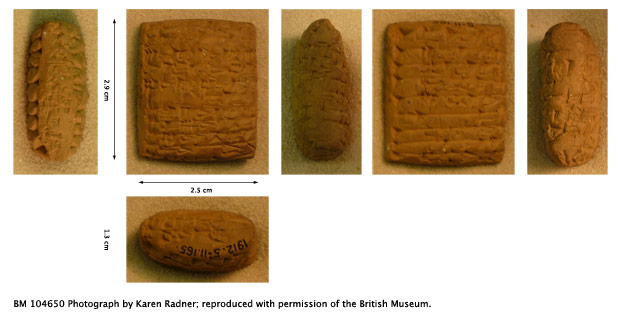BM 104650: issue of rations for messengers, from Umma

BM 104650: issue of rations for messengers, from Umma, reign of Ibbi-Suen (Ur III period, c. 2010 BC). Photograph by Karen Radner; reproduced with permission of the British Museum. View large image.
The Ur PGP III empire of the 21st century BC is sometimes judged to have been an overbearing bureaucracy, obsessed with controlling the smallest of details. It is at least true that the scribes who worked over the course of these 100 or so years have bequeathed us an incredible wealth of documentation. Tens of thousands of texts have survived, most of them from just a 30-year period. These archives allow us to witness the functioning of a sophisticated re-distributive economy.
This tablet belongs to a category known as "messenger texts", so called because they record standard issues of rations (such as bread, beer, oil or onions) to a series of people who are described as messengers, couriers or the like. Sometimes a note will specify where each is coming from or going to. These tablets were characteristically small, often the size of a postage stamp, with correspondingly small script. This was not because they were designed to be carried by messengers, however. Rather these tablets belong to the local administrative units through which the messengers passed at unpredictable intervals. We can only guess at the annoyance felt by the accountants whose careful calculations were thrown awry by these visitors.
Messengers were vital to the running of the empire. The speed of the courier service was maximised by the existence of royal roads with way-stations, where the messengers could break their journey. King Šulgi boasted of his impressive infrastructure in a praise poem [http://etcsl.orinst.ox.ac.uk/cgi-bin/etcsl.cgi?text=t.2.4.2.01#]:
I, Šulgi, the mighty king, superior to all ... strengthened the roads, put in order the highways of the Land. I marked out the double-hour TT distances, built there lodging houses. I planted gardens by their side and established resting-places, and installed in those places experienced men. Whether travelling from north or south, one can refresh oneself in their cool shade; and travellers and wayfarers who arrive at night can seek haven there as in a well-built city.
View the record for this tablet on the British Museum's research database [http://www.britishmuseum.org/research/search_the_collection_database.aspx].
A transliteration of the messenger text can be found in d'Agostino & Pomponio, Umma Messenger Texts (2002), no. 139.
Content last modified on 10 Jan 2017.
Jon Taylor
Jon Taylor, 'BM 104650: issue of rations for messengers, from Umma', Knowledge and Power, Higher Education Academy, 2017 [http://oracc.museum.upenn.edu/saao/knpp/cuneiformrevealed/tabletgallery/bm104650/]